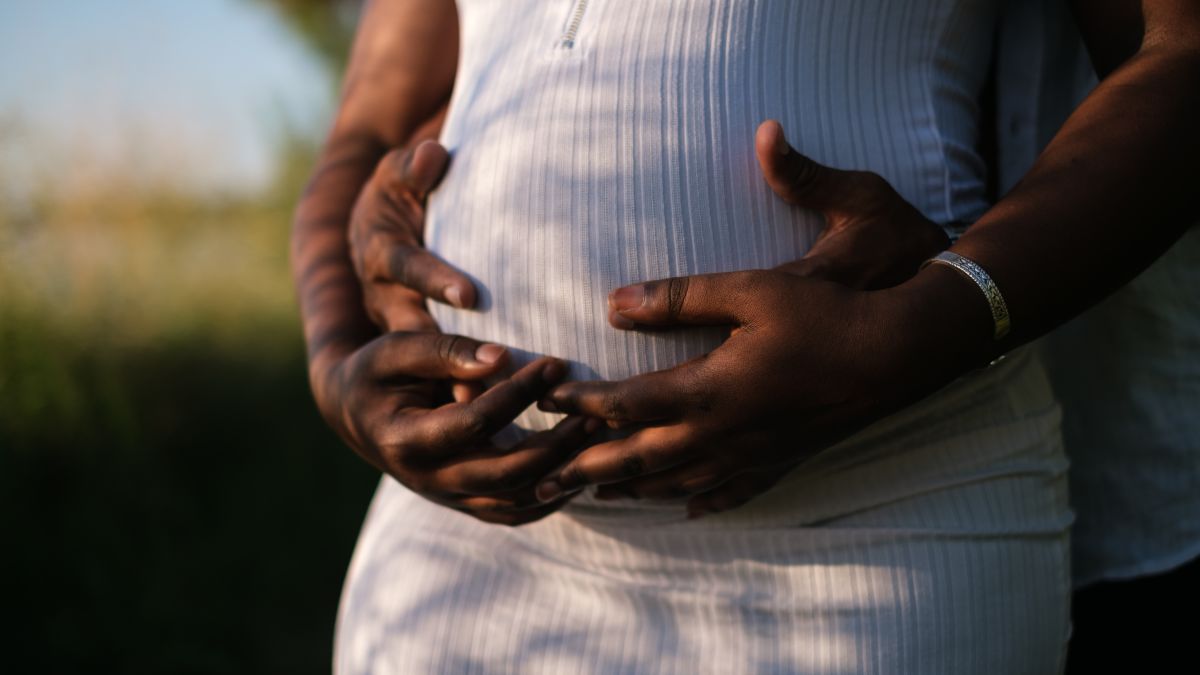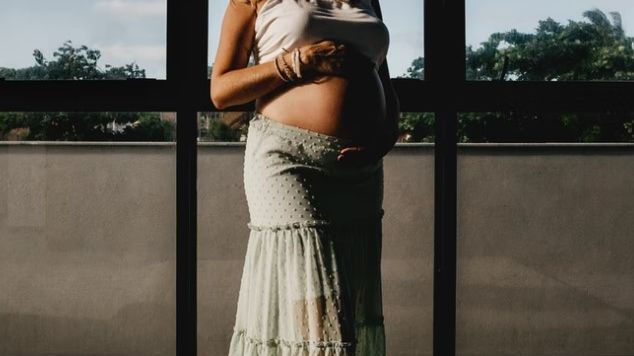Movement

Fetal movement is a positive sign of healthy growth and development and proves the fetus is growing in both size and strength.
Feeling a baby’s movement is a major – and exciting – milestone for women. Women who are pregnant with their first baby may begin to feel movement between 18 and 22 weeks, while women with a prior pregnancy may feel movement as early as 16 weeks.
Although kick-counting remains very popular, recent research indicates that since there is no set number of kicks a fetus should have within a certain amount of time, the best recommendation is for women to have a general awareness of their own babies’ movements beginning around 28 weeks, and report any change or concern to their health care provider (HCP).
Background
Fetal movements are key markers of fetal health throughout pregnancy. A woman’s general awareness of these movements, their pattern, and their increasing strength serves as a critical benchmark when assessing any potential decrease in movement; this awareness also serves as an important bonding exercise.

Fetal movements are characterized by frequency, intensity, pattern, and duration, and are commonly described as flutters, bubbles popping, hiccups, gentle kicks, puffs of air, rolling, butterflies, stretching, turning, and swishes.
Movement can be observed as early as 8 to 10 weeks of pregnancy via ultrasound but is usually not felt – by first-time mothers – until around 18 to 22 weeks (known as “quickening”). Women who have previously felt fetal movements may feel movement as early as 16 weeks in subsequent pregnancies.
An experienced HCP may be able to feel fetal movement through the abdomen by 20 weeks.
Frequency and Strength
From 10 to 20 weeks of pregnancy, fetal body movements are usually never absent for more than an average of 13 minutes. From 20 weeks onward, the fetus likely moves at least once every minute and is active an estimated 10% to 30% of the day.
However, not all of these movements are felt – in one study, mothers only perceived 33% to 88% of movements that were seen on ultrasound. Further, women can find it hard to detect more subtle fetal movement unless they are sitting or lying down.
The greatest frequency of fetal movements appears to be in the late evening; it is also theorized that male fetuses tend to be more active than females.
Between 20 and 30 weeks of pregnancy, movements become organized and the fetus starts to show sleep-awake (or rest-activity) cycles.
Fetal sleep cycles, in which movement is usually absent, mostly last between 20 and 40 minutes, and are rarely longer than 90 minutes. These sleep cycles have no correlation to a woman’s sleeping pattern, and can occur at any time of day.

The frequency of fetal movements reaches a plateau around 32 weeks and stays at that frequency until birth. While the character of fetal movements changes when pregnancy approaches 40 weeks due to limited space in the uterus, the frequency and strength does not normally decrease.
According to a study published in November 2021, increasing strength of fetal movements was the most commonly reported (> 60%) pattern by women in late pregnancy, which were associated with a decreased odds of late stillbirth. Interaction analysis showed increased strength of movements had a greater protective effect and decreased frequency of movements greater odds of late stillbirth at preterm gestations (28–36 weeks’ gestation).
Further, fetal hiccups and regular episodes of vigorous movement were associated with decreased odds of late stillbirth.
Decrease in Movement
In normal pregnancies, there is a wide range in the number of fetal movements in any given hour, and many outside factors can temporarily affect frequency. However, some complications – especially late in pregnancy – have been associated with a decrease in fetal movement. Therefore, awareness of a decrease in movement may be useful as a “warning sign".
A study published in July 2021 investigated cases of stillbirth to identify associations with reduced fetal movements (RFM). The study confirmed the relationship between RFM and placental insufficiency among study participants. Placental insufficiency is a term used when the placenta cannot adequately delivery oxygen and nutrients to a fetus.
Overall, reduced fetal movements appear to be associated with fetal growth restriction, placental problems, fetal hypoxia (lack of oxygen), true umbilical cord knots, congenital malformations, small for gestational age, preterm birth, and stillbirth. However, these complications are rare, and there are numerous factors that can give the perception of a decrease in fetal movement such as:
Placental location (anterior – but only until about 28 weeks)
Benzodiazepines, methadone and other opioids
Fetal position
Any woman concerned about her baby’s movement during pregnancy should call her HCP.
Monitoring Movement
Due to a reduction in fetal movement prior to the complications described above, it is theorized that if women are aware of their babies’ movements, and detect a decrease, that potential early intervention (such as delivery) can prevent those complications.
There is no normal set number of movements/kicks per hour for all fetuses – only abnormal for one particular fetus.
There is no normal – only abnormal for one particular fetus. In normal pregnancies, there is a wide range in the number of fetal movements in any given hour, and no particular “number” regarding frequency per hour has been established (i.e. there is no “a baby should move X number of times in X amount of time").
However, because there is very little variation in movement in a specific pregnancy, as fetuses settle into patterns, the important distinction is for women to recognize a change in movement pertaining to their baby’s normal pattern of movement.
HCPs recommend that pregnant women start learning a general awareness of their babies’ movements around 28 weeks of pregnancy and continuing until delivery. Paying attention to fetal movements without distraction can also positively enhance bonding between mother and baby.
If pregnant women have a general awareness of the pattern of their baby’s movements, this may be just as effective and cause less anxiety than kick-counting.
Note: It is a commonly held belief that eating or drinking something cold or sugary will stimulate fetal movements, but this is not backed by evidence. However, it is known that movements may not be felt very often by women who are distracted, standing, or sitting, and may be felt best when a woman lies on her left side, free of distraction, and concentrates on movements.

If there is a change or decrease in a baby’s normal pattern of activity, the woman is advised to call her HCP, who will perform an ultrasound and/or a nonstress test. Concern of decreased fetal movement is a common cause of HCP visits in the third trimester.
Again, although no specific number has been identified, in research that has been published, it appears that most women can feel at least 10 movements within 10 to 60 minutes.
Interest in kick-counting was very high during the 1970s and 80s when research indicated the use of these charts reduced stillbirth rates. However, additional research from the late 1980s through the present has determined that since there is no “normal” number of fetal movements, then kick-counting may not be accurate, especially when using “ten movements in two hours” .
However, kick-counting itself is not necessarily ineffective, but tying the movements to a specific number across all pregnancies is not based on current evidence.

Women need to determine what method works best for them. Even though "ten movements in two hours" may not be accurate for all pregnancies, it may be helpful to use these charts not to reach a certain number in a certain amount of time, but to help determine a baby’s pattern. Other women may not need a chart and will recognize their baby’s patterns in a more passive way, while focusing on the quality of movement.
A woman’s attention to her own baby’s movement is an important tool during pregnancy since reliable monitoring of fetal movement patterns outside a doctor’s office or hospital is not available. Although some companies are attempting to find a “wearable” device at home that can monitor movement accurately, the technology to do so does not currently exist.
Excessive Movement
A potential cause or definition of “excessive” fetal movements is not known and information regarding excessive movements is very limited. It has been theorized that true excessive movement could represent a sign of distress, seizures (infection/lack of oxygen), or an attempt to detangle from the cord (but current evidence does not support this).
An April 2022 journal pre-proof found that sudden episodes of increased fetal movement do not seem to be associated with adverse neonatal outcomes or umbilical cord complications. Overall, 43,714 women were in the study cohort, including 282 (0.65%) presenting with IFM, who were compared to 43,432 (99.35%) who reported no change in fetal movement during pregnancy. No differences were found between groups in terms of the severe and mild composite adverse neonatal outcomes, as well as any other neonatal complication, including umbilical cord complications (around the neck, around the body, around body or neck, or true cord knot). No cases of stillbirth or intrapartum death were found in the IFM group.
A July 2020 study of 77 women who reported increased fetal movement did not find evidence of an association between this increased movement and any adverse pregnancy outcomes. It also did not find evidence of placental dysfunction, umbilical cord concerns, a lack of oxygen, or infection.
Fetal hiccups can appear as excessive movements, especially in a short time frame and are known to be harmless. Hiccups are frequently noted by pregnant women in the second half of pregnancy as jerky movements which can “come and go”. Read more.
Movements are very subjective, and it is possible that women may perceive an excess when no danger exists. Regardless, women should always call an HCP with any concerns.

Action
Whether a woman chooses to have a general awareness of her baby's movements, or decides to use kick-counting to achieve this is completely up to her; these methods are meant to help reassure women and relieve anxiety.
Women should always try to concentrate on their baby's movements whenever they can. The most optimal way may be to find a quiet place to lie down (on left side) and be free of distraction. Doing this properly usually provides significant comfort, reassurance, and tends to prevent "false-alarms".
However, any woman concerned about her baby’s movement (or lack thereof) during pregnancy should call her HCP. While it is understandable that women may be afraid to schedule a "false-alarm" visit, women should also understand that calling as soon as they notice a potential change could possibly prevent complications (although these are rare).
Women should also consider sharing their fetal movement experience below for other pregnancy women, to include when they first felt movement and what the movement felt like.
Resources
Fetal Movement (StatPearls/NCBI)